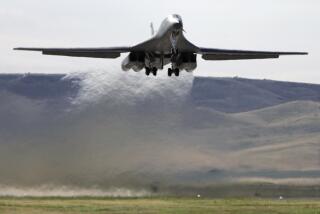Report Says FAA May Have Lagged on 757 Wake Peril
WASHINGTON — The Federal Aviation Administration may have mishandled reports on turbulence problems associated with Boeing 757s because it doesn’t have the proper procedures to ensure that safety concerns are acted upon in a timely fashion, according to a federal report released Tuesday.
The 46-page report, a joint effort by the FAA and the Department of Transportation, concluded that some officials within the FAA believe the agency could have acted sooner in taking steps designed to prevent accidents caused by wake turbulence from Boeing 757s. Others in the agency, however, do not share that view, the report said.
Aside from the conflicting views on whether the agency mishandled the issue of 757 wake turbulence--a phenomenon that has been linked to two fatal airplane crashes--the panel assembled by U.S. Transportation Secretary Federico Pena and FAA Administrator David R. Hinson found a consensus within the FAA that the agency’s ability to spot potential safety threats and take appropriate action is lacking.
“The B-757 wake vortex episode should serve as a wake-up call to the FAA to re-examine its processes for addressing emerging safety issues promptly and effectively,” wrote the two officials who headed the review team, Transportation Department General Counsel Stephen H. Kaplan and Deputy FAA Administrator Linda Hall Daschle.
Although the report maintained that the FAA has an “unparalleled” safety record, it sent a clear message--as well as a list of recommendations--to Hinson and Pena that the agency could do better.
Daschle said during a discussion of the report that bureaucracy and a lack of leadership and clout have compromised the efficacy of the Office of Aviation Safety, whose job it is to identify, analyze and otherwise call attention to safety-related issues.
Pena and Hinson ordered the review in mid-June after a series of reports in The Times indicated that the FAA knew about the potential danger of 757 wake turbulence long before two crashes that claimed 13 lives.
Caused by the rapid movement of air across aircraft wings, wake turbulence amounts to a pair of “horizontal tornadoes” emanating from each wingtip. Although aviation experts disagree on the level of danger, some believe that the sleek wing and body design of the fuel-efficient 757 can cause wake turbulence that is more powerful and lasts longer than that created by other aircraft of comparable size.
Relying on FAA internal documents and aviation safety sources, The Times reported June 5 that the FAA’s top scientist repeatedly expressed concerns about 757 wake turbulence, and in December, 1992, warned that it could be lethal and might cause a “major crash” if the agency failed to act. On Dec. 18, 1992, eleven days after Robert E. Machol’s prediction, a crash did occur in Billings, Mont., killing eight people. In December, 1993, five people died in Santa Ana after a corporate jet encountered the wake from a 757 on approach to John Wayne Airport.
Reacting to recommendations made in February by the National Transportation Safety Board, the FAA last month instituted a new set of policies governing smaller planes landing and taking off behind 757s, including an extra mile of spacing on final approach. The agency also has embarked on an aggressive program to educate pilots and air traffic controllers about the potential 757 wake turbulence hazard.
A congressional subcommittee is scheduled to take up the specific issue of whether the FAA tarried too long before acting on 757 wake turbulence concerns, as well as the general topic of whether the people who detect potential safety problems within the FAA communicate effectively with the agency’s policy-makers and decision-makers.
In its report, the FAA and Transportation Department were unwavering in the opinion that nothing the FAA could have done would have prevented the Billings crash. Safety investigators have concluded that the pilot in that accident was operating under visual flight rules, meaning it was up to him to maintain a safe distance behind the 757 he was tailing. Other aviation safety officials have suggested, however, that had the FAA called attention to the potential 757 turbulence hazard earlier, the Billings pilot might have been more prudent.
Because the safety board has not finished its investigation of the Santa Ana crash, the report did not speculate whether the FAA could have affected the outcome of that crash.
Like the pilot in the ill-fated Billings accident, the pilot in the Santa Ana crash was operating under visual flight rules. He, too, had inadvertently strayed too close to the 757 and dropped below the flight path of the 757, which made his smaller plane more susceptible to the wake turbulence.
The panel that compiled Tuesday’s report recommended that the FAA:
* Review the role of the Office of Aviation Safety and create a more effective mechanism to address safety issues.
The agency lacks “a single organization, mechanism or entity” that can identify potential safety problems, alert others within the agency and follow up on safety recommendations, the report said.
* Take a more proactive approach when it comes to communicating potential safety hazards to pilots, air traffic controllers or others in the industry.
* Better define who’s responsible for what within the agency.
* Improve research and development, including that involving wake turbulence.
More to Read
Inside the business of entertainment
The Wide Shot brings you news, analysis and insights on everything from streaming wars to production — and what it all means for the future.
You may occasionally receive promotional content from the Los Angeles Times.










